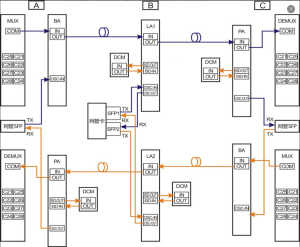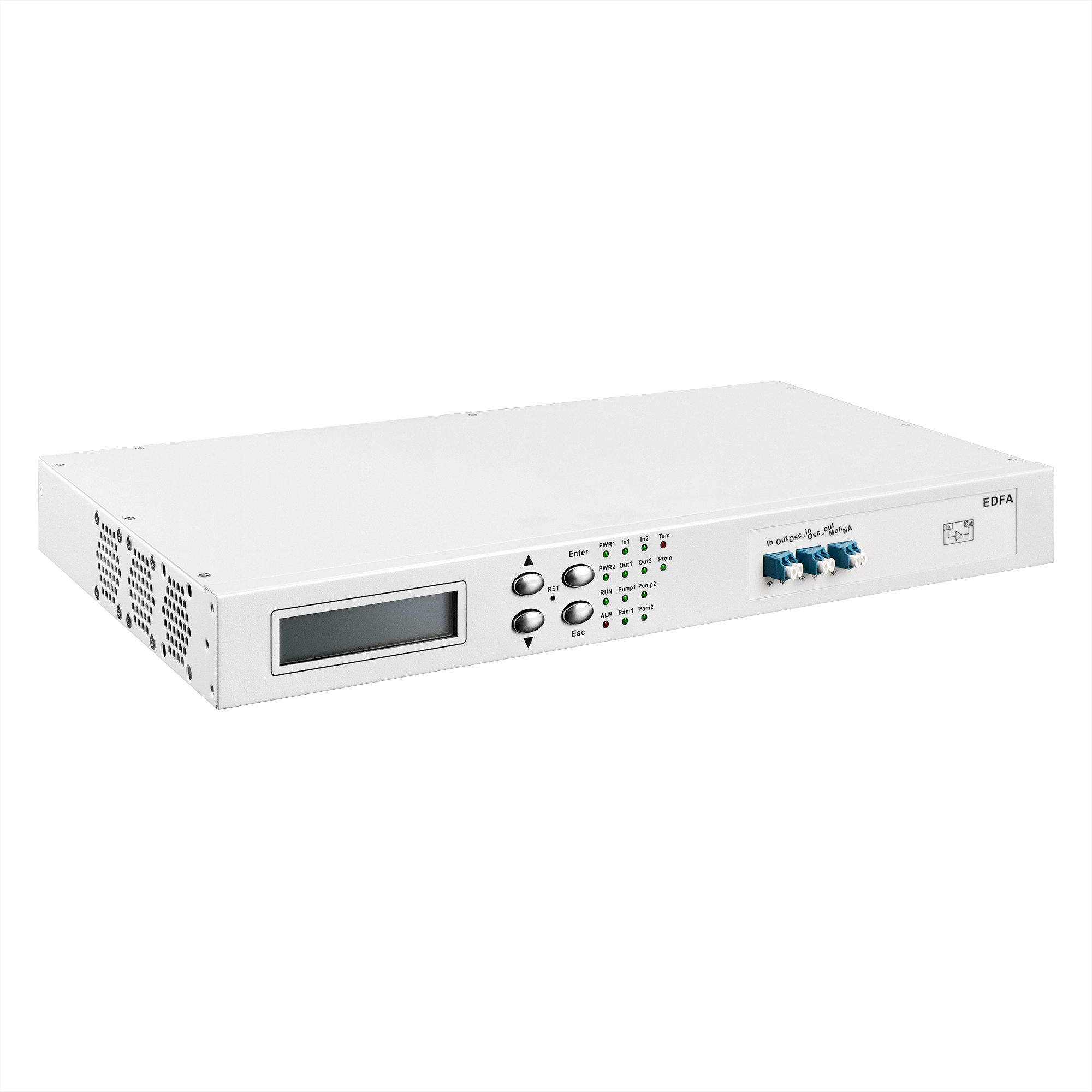EDFA Rack-Mount / 1U Chassis-Based
This EDFA (Erbium Doped Fiber Amplifier) equipment is designed to amplify optical signals in the C-band, supporting DWDM systems with up to 96 channels. It offers flexible application as a booster, line, or pre-amplifier, and features high output power, low noise figure, and stable gain.
Equipped with an intuitive LCD display and web-based management, it allows real-time monitoring and adjustment of operating modes, including AGC and APC. Ideal for long-distance optical transmission networks, this amplifier ensures reliable performance with comprehensive alarm functions and robust environmental adaptability.
Description
Overview of EDFA
The main function of EDFA(Erbium Doped Fiber Amplifier) optical amplification equipment is to compensate the power of signal light in the transmission link, and can simultaneously amplify the optical signals of up to 48 channels (channel interval is 100GHz) or 96 channels (channel interval is 50GHz) in C- band. It has the characteristics of flat gain, adjustable gain and small noise index, it is an indispensable part of DWDM system and future high-speed system, all-optical network long-distance transmission.
EDFA amplifier from the application position can be divided into: power amplifier, line amplifier, preamplifier;
BA power amplifier: It has the characteristics of high input power, high gain and high output. It is mainly used at the transmitting end of DWDM system to improve the optical power of DWDM system;
LA line amplifier: It has the characteristics of low input power, high gain, high output, etc. It is mainly used in the middle of two network nodes in DWDM system to improve the transmission power of DWDM system;
PA preamplifier: It has the characteristics of low input power, high gain and low output. It is mainly used for DWDM system terminal to improve the received optical power of DWDM system.
Product features
(1) Support C- band DWDM system optical amplification;
(2) support optional with OSC signal input amplification function;
(3) support power amplification, line amplification (two optical amplification), pre-amplification;
(4) Can monitor: pump drive current, pump output power, pump switch, pump temperature, input optical power, output optical power, module temperature;
(5) support can be set to pump switch, AGC mode and APC mode (input and output optical power adjustable).
(6) Support optical monitoring port (MON).
(7) the use of LCD display, very intuitive display data, user-friendly operation.
Product Specifications |
| Function | Description | |
| Operating wavelength range |
Standard type: 1529nm ~ 1561nm Extended type: 1528nm ~ 1568nm | |
| EDFA Type | OBA Power Amplification | OPA Power Amplifier |
| Minimum input optical power |
-22dBm | -32dBm |
| Maximum output optical power |
+ 20dBm | + 16dBm |
| Maximum Gain | 17dB | 20dB |
| Noise factor | <5.5dB | |
| gain flatness | <1.5dB | |
| Specific technology |
Support gain lock, gain adjustable, transient control technology, output optical power automatic shutdown |
|
| Network Management Function | Support real-time monitoring of EDFA working status, including: optical power, pump, temperature, etc. Support pump off threshold and automatic recovery time setting function |
|
| Optical Interface | LC/UPC (customizable) | |
| MTBF | > 100000 hours | |
EDFA Device Interface Definition |
||
| Interface screen printing |
Name | Features/Links |
| In | EDFA input interface | Small signal optical power input port. |
| Out | EDFA output interface | EDFA Amplified Output Optical Port. |
| OSC_IN | Monitoring channel input port |
Link network management card SFP TX to transmit network management information. |
| OSC_Out | Monitoring channel output | Link network management card SFP RX, transmission network management information. |
| MON | Monitoring port | EDFA performance monitoring interface, link OPM or spectrometer. |
| single disk monitoring information Online real-time monitoring of EDFA single disk working status; |
|||
| Real-time monitoring of EDFA input optical power, output optical power; | |||
| Real-time monitoring of EDFA Pump working status; | |||
| Real-time monitoring of EDFA working current, power consumption, die temperature, cooling current, etc; | |||
| Can set the input and output light threshold, set the EDFA working mode, output power threshold, gain, etc; | |||
| EDFA Device Settings 1. Input and output power alarm threshold setting The amplifier input and output power alarm threshold can be set through the network management, when the input power is lower than the threshold, EDFA alarm, at this time EDFA pump is turned off, EDFA does not work, EDFA output below the threshold will prompt alarm; 2. Working mode setting The amplifier working mode can be set through the network management: AGC constant gain mode, APC constant output mode and ACC constant current mode. The gain can be set in AGC mode with the best setting range of ± 1db. The output power can be set in APC mode with the best setting range of ±1dBm; |
|||
| 3. Setting of eye protection mode
When installing, debugging or dealing with faults, the amplifier eye protection mode can be opened through the network management to reduce the output power of EDFA and avoid harming maintenance personnel; Connection diagram of 4.7 works |

Description:
- MUX coupler COM port is connected to BA input port IN,BA output port OUT is connected to long-distance optical cable to transmit large signal light, and OSC-in port is connected to network pipe card optical port Tx transmitting port;
- The network management card SFP TX is connected to the OSC-IN interface of BA OSC channel, and RX is connected to the OSC-OUT interface of PA OSC channel;
- The OSC channel OSC-IN and OSC-OUT of LA1 are respectively connected to Rx of SFP1 and Tx of SFP2 of network pipe card optical port, and the OSC channel OSC-IN and OSC-OUT are respectively connected to Tx of SFP1 and Rx of SFP2 of network pipe card optical port to realize cascaded bidirectional transmission of network pipe card

